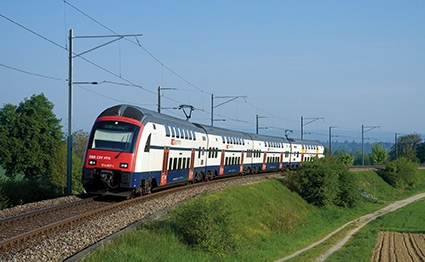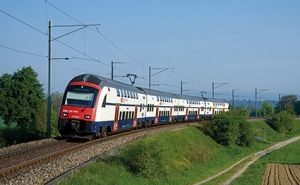Latvia, Azerbaijan Agree on Intercontinental Multi-Mode Transport Route
Latvia and Azerbaijan have plans to expand cooperation regarding the transport of Azerbaijani goods to Europe, Latvia’s Ministry of Transport told Baku-based Trend News Agency last week.
"We see great prospects for expanding our cooperation in the area of increasing the export of Azerbaijani goods to the European market. The opening of the Azerbaijan’s Trade House, held in Riga on July 23 in the framework of the visit of the Deputy Minister of Economy of the country, Sahib Mammadov, will give a new impetus to the bilateral cooperation. We are confident that as the volume of sales increase, the volume of freight traffic between our countries will increase. And we also see ample opportunities for the creation in the future of trade, logistics and manufacturing enterprises for the products of Azerbaijan in Latvia for their further processing and distribution in the markets of the Baltic states, northern and western Europe," the ministry said.
Azerbaijan is an important player in the field of transport and logistics in the Trans-Caucasian region, bordering the Caspian Sea to the east, Iran to the south, and Armenia, Georgia, and Russia to the north. The Trans-Caspian International Transport Route (TITR) starts from Southeast Asia and China, runs through Kazakhstan, the Caspian Sea, Azerbaijan, Georgia and on to Europe. The multi-mode container line ‘Nomad Express’ organizes regular container trains from China to Turkey and Europe in 14-15 days. 3 million tons of cargo are expected to be moved through the TITR in 2018. The agreement creating a coordinating committee to develop the TITR was initially signed in late 2013 by representatives from Kazakhstan, Georgia, and Azerbaijan. The first test container train was sent from China to Baku in August 2015.
The ministry noted that China’s One Belt, One Road initiative is creating new possibilities to develop logistics supply chains across the region. "The international transport corridor ‘North-South’ is included in the list of priorities of the Latvian logistics industry represented by the state company Latvian Railway JSC. A multi-mode route India-Iran-Azerbaijan-Russia-Latvia is being created in order to ensure regular container traffic. It is envisaged that the proposed logistics solution will ensure an efficient, reliable and rapid flow of goods from India to Europe. The access to the region of the Baltic countries and northern Europe, as well as to eastern and western Europe will be gained with the use of the advantages and logistics services of Latvia in the direction of the international transport corridor North-South,” said a ministry spokesperson.
The proposed route will operate in the framework of the International North–South Transport Corridor (INSTC) – a 7,200-km-long multi-mode ship, rail, and road network for moving freight between India, Iran, Afghanistan, Armenia, Azerbaijan, Russia, Central Asia and Europe.
In addition to the INSTC, TRACEA, the Europe-Caucasus-Asia transport corridor, also passes through Azerbaijan. TRACEA is a part of the new Silk Road and links the Caspian and the Black Seas. In light of Azerbaijan’s strategic transport links, the Latvian Ministry of Transport said that they “believe that Azerbaijan has excellent prospects for the development of freight transport. The development of railway communication with Iran will strengthen the North-South corridor, and the recently opened Baku-Tbilisi-Kars railway line will develop freight traffic in the East-West direction.”
The ministry offered Azerbaijan "the opportunity to supplement its logistics routes in North-South and East-West directions with access to the market of northern and western Europe through our railway and ports – Riga, Ventspils, Liepaja.”
The ministry also emphasized existing cooperation between Latvia and Azerbaijan in air transportation, saying, "We are glad that our national airline Air Baltic, in cooperation with Azerbaijan Airlines, serves the passenger transportation between Riga and Baku twice a week in the summer season, and Air Baltic is extending the period of flights by 10 weeks this year. This will undoubtedly contribute to the development of tourism and business contacts between our entrepreneurs.”
Earlier this month, Azerbaijan’s Transport, Communications and High Technologies Ministry released a statement saying that, in a meeting of an Azerbaijan-Latvia joint commission on international road networks between the two countries, it was agreed that efforts will be made to increase bilateral road transportation between Azerbaijan and Latvia by 20% in 2019.
Late last week, the Latvian Ministry of Transport invited Azerbaijan Railways to join the ZUBR transport project. ZUBR is a container block-train running north-south between the Baltic and Black Seas. The operational principles were agreed on between Estonian, Latvian, Belorussian and Ukrainian railway administrations in 2009, and regular traffic flow started in 2012.
"Azerbaijan, in the context of further development of the ZUBR project, plays a very important role," the ministry told Trend News Agency. "Latvia sees potential for development of the ZUBR project in Azerbaijan to attract cargo from Central Asia and China through the TRACECA corridor, as well as cargo from India, Iran and other countries of the Middle East and South Asia through the North-South corridor."
Joining ZUBR would provide an opportunity for the export and transit of goods from and through Azerbaijan to Latvia, and possible distribution throughout the Baltic countries, Scandinavia, and other parts of Europe. It would also, of course, facilitate imports to Azerbaijan from Europe.
While Azerbaijan Railways has not yet officially responded to the invitation, Latvia’s Ministry of Transport confirms that Azerbaijan is interested in the project. Georgia has also expressed interest in participating in ZUBR.
Samantha Guthrie











